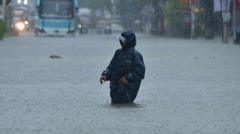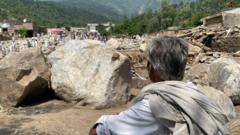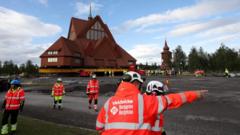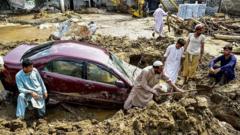As India's financial capital, Mumbai faces significant challenges as heavy rain leads to substantial disruptions and widespread evacuations.
Mumbai's Deluge: Heavy Rains Disrupt Life and Transport in India's Financial Hub

Mumbai's Deluge: Heavy Rains Disrupt Life and Transport in India's Financial Hub
Intense rainfall has brought Mumbai to a standstill, affecting millions and disrupting travel as the city grapples with severe flooding.
Heavy rainfall in Mumbai has thrown the city into chaos, with emergency services struggling to manage the impact of knee-deep water in many areas. The situation has resulted in the cancellation of numerous flights and train services across the region. Videos shared online show residents navigating submerged streets, with litter and debris floating as a result of blocked sewers. Local authorities have reported that nearly 600 individuals were rescued after being trapped in an overcrowded monorail that stalled mid-journey, with some passengers suffering from suffocation. Schools and colleges are largely closed, and approximately 350 residents from vulnerable areas have been evacuated to temporary shelters.
As the India Meteorological Department issues a red alert for further heavy rainfall, conditions are expected to improve later in the week. However, over a four-day period, the city has experienced unprecedented rainfall levels, logging 800mm, much higher than the typical amounts for August. Sadly, at least 21 fatalities have been linked to rain-related incidents across the state.
The city’s essential local train network, crucial for daily commuters, faced major interruptions, with long lines forming as delays piled up. A spokesperson for a local news agency shared that trains scheduled for late Monday had only departed early Tuesday, causing frustration among passengers.
The international airport also felt the repercussions, with reports of at least 50 flight cancellations amid ongoing rain forecasts, raising concerns about impending congestion and operational delays. Amid these challenges, a monorail incident saw passengers trapped due to overcrowding, leading to emergency services using cranes for extraction efforts.
Criticism has emerged toward the government for its lack of preparedness, particularly from opposition lawmakers who highlighted an "absolute failure in governance." Accusations of negligence regarding planning and infrastructure investment were voiced, especially surrounding the city’s recently expanded but inadequate drainage systems.
As over 12 million people reside in Mumbai—a city that has increasingly attracted migrants in search of opportunity—the need for effective urban planning and climate-ready infrastructure has never been more urgent. Despite various modernization projects, the city continues to struggle with the effects of its aging infrastructure.
As the India Meteorological Department issues a red alert for further heavy rainfall, conditions are expected to improve later in the week. However, over a four-day period, the city has experienced unprecedented rainfall levels, logging 800mm, much higher than the typical amounts for August. Sadly, at least 21 fatalities have been linked to rain-related incidents across the state.
The city’s essential local train network, crucial for daily commuters, faced major interruptions, with long lines forming as delays piled up. A spokesperson for a local news agency shared that trains scheduled for late Monday had only departed early Tuesday, causing frustration among passengers.
The international airport also felt the repercussions, with reports of at least 50 flight cancellations amid ongoing rain forecasts, raising concerns about impending congestion and operational delays. Amid these challenges, a monorail incident saw passengers trapped due to overcrowding, leading to emergency services using cranes for extraction efforts.
Criticism has emerged toward the government for its lack of preparedness, particularly from opposition lawmakers who highlighted an "absolute failure in governance." Accusations of negligence regarding planning and infrastructure investment were voiced, especially surrounding the city’s recently expanded but inadequate drainage systems.
As over 12 million people reside in Mumbai—a city that has increasingly attracted migrants in search of opportunity—the need for effective urban planning and climate-ready infrastructure has never been more urgent. Despite various modernization projects, the city continues to struggle with the effects of its aging infrastructure.


















